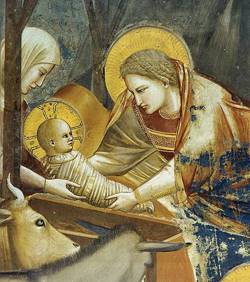
A painting of the Nativity by Italian artist Giotto di Bondone (1266-1337).
Since at least the fourth century in Rome, Christians have celebrated the incarnation and nativity of Jesus Christ on December 25. There is more than one theory about the origin of this festival day. Some have suggested that it was established to replace the Roman feast of Natalis Solis Invicti (the “birthday of the unconquered sun”). Others believe that Jesus was conceived on March 25 (coinciding with the date of his crucifixion, as recorded by some witnesses in the early church); December 25 is exactly nine months later.
Regardless, the time between December 25 and January 6 (Epiphany) has become an occasion for the church to celebrate and give thanks for the arrival of God’s Word made flesh — the light of God that has come into the world, the light that even death could not extinguish.
The Word became Flesh
An excerpt from the Companion to the Book of Common Worship (Geneva Press, 2003, 92-93)
What is “Christmas”? It is three words: God in flesh; or four syllables: in-car-na-tion. The Gospel according to John (1:14) tells us, “The Word became flesh and lived among us, … full of grace and truth.” Christmas proclaims that God has come in flesh, has come “to save us all from Satan’s power.” Christmas celebrates far more than a birthday; Christmas acclaims the advent of messianic salvation. Christ was sent among us in order to save us. …
What we pay homage to at Christmas, therefore, is that the ultimate fulfillment of God’s saving purpose begins with the birth of Jesus, the messianic Savior. God’s only Son is born among us in order to save the world. This is the message of Christmas.
From the beginning of time, God’s saving purpose has been at work. God has raised up the seed of Abraham, including Moses and Gideon and Samson and John the Baptist. Through all these generations, God has been faithfully at work raising persons to bring us the Davidic Messiah, the messianic King, the Son of the Most High who will ascend the throne of David. Through all of human history, God has been bringing forth Jesus Christ. Now through the birth of the Savior, God’s purpose will be fulfilled. God has acted to save God’s people. The Christ child is born for the saving of the world.
Lectionary readings for Christmas
Read the Revised Common Lectionary Scripture lessons for the Nativity of the Lord:
Resources for Christmas
Coming Soon: 2020 Service of Lessons and Carols
Adapted from the 1918 King’s College liturgy for a Service of Lessons and Carols, this prerecorded video from the PC(USA) national offices is provided for congregational use during this Christmas season. It features: a sermon from the Reverend Dr. J. Herbert Nelson, II, Stated Clerk of the PC(USA); a prayer and blessing from the Reverend Dr. Diane Moffett, President and Executive Director of the Presbyterian Mission Agency; Scripture readings from Reverend Gregory Bentley and Ruling Elder Elona Street-Stewart, Co-Moderators of the 224th General Assembly (2020); and Christmas songs from a variety of traditions. The full text of the service is available; brief orders of worship and video captions are provided in English, Korean and Spanish.
Prayers for Christmas
These prayers might be used in a variety of settings: Opening Prayers (at the beginning of worship) or concluding collects (after the Prayers of the People); for church websites or newsletters; or in personal, small group or family devotion.
Find resources for the Nativity of the Lord from Biblical and Confessional Resources for Worship.
Season of Advent | Epiphany of the Lord